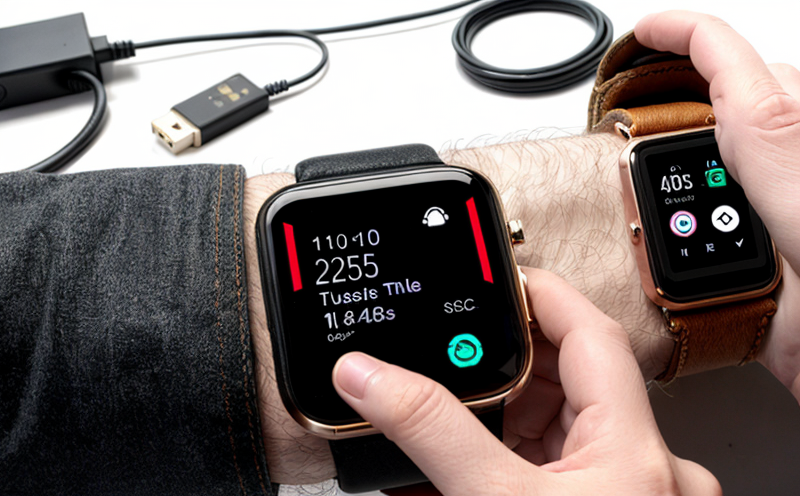ISO 9241 Ergonomics and Human Factors Testing for Wearables
The International Standard ISO 9241-210: Ergonomics of human-system interaction - Part 210: Guidelines for the design of interactive computer systems (including mobile devices) is a cornerstone in the development and evaluation of wearable electronics. This standard focuses on the ergonomic aspects ensuring user comfort, safety, and efficiency while interacting with these devices.
The testing process involves several key steps to ensure compliance with ISO 9241-210 guidelines:
- Usability Testing: Evaluating how users interact with the device under various conditions. This includes assessing ease of use, learnability, efficiency, and error rates.
- User Interface Design Review: Ensuring that the interface design is intuitive and promotes a good user experience.
- Performance Metrics: Measuring how well the system meets usability criteria such as response time, accuracy of input data, and overall performance stability.
- User Acceptance Testing (UAT): Conducting tests with real users to gather feedback on their experiences. This helps identify any issues that need addressing before finalizing the product.
Our laboratory adheres strictly to these guidelines when performing ISO 9241-210 compliance testing. Our team of experts uses advanced tools and methodologies to simulate various real-world scenarios, ensuring thorough evaluation across all relevant dimensions.
This type of testing is crucial for manufacturers looking to bring innovative products into the market successfully. By adhering strictly to international standards like ISO 9241-210, companies can ensure their wearable devices meet high-quality benchmarks recognized globally, enhancing user satisfaction and trust.
Scope and Methodology
The scope of our ISO 9241 Ergonomics and Human Factors Testing for Wearables service includes a comprehensive evaluation of the ergonomic aspects that impact user experience. This encompasses both physical comfort (such as fit and positioning) and cognitive load, which refers to the mental effort required by users to interact with the device effectively.
The methodology employed involves multiple stages:
- Initial Assessment: Conducting an initial assessment of the wearable design to identify potential ergonomic risks.
- User Testing: Performing usability tests with actual end-users in controlled environments. This step aims at identifying any discrepancies between expected performance and actual user experience.
- Data Collection: Gathering quantitative data on metrics such as keystroke velocity, error rates, and response times during interaction tasks.
- Feedback Analysis: Analyzing qualitative feedback from participants to understand their perceptions about the device's design and functionality.
- Report Generation: Preparing detailed reports outlining our findings along with recommendations for improvement where necessary.
We follow this structured approach because it allows us to provide thorough, reliable evaluations that meet stringent industry standards. Our goal is not only compliance but also enhancement of product quality through insightful feedback and actionable insights derived from rigorous testing processes.
Why Choose This Test
Selecting the appropriate tests for your wearable electronics is vital to ensure they are safe, comfortable, and functional. Here’s why choosing ISO 9241-210 compliance testing matters:
- Global Recognition: Compliance with this standard assures international recognition, making it easier for companies to enter new markets.
- Better User Experience: Ensures that the device is designed in a way that enhances user satisfaction and reduces stress during use.
- Enhanced Reliability: By identifying potential issues early on, manufacturers can improve product reliability significantly.
- Promotes Innovation: Adhering to such standards encourages continuous innovation by ensuring that new designs are built upon proven principles of human-centered design.
- Compliance Costs Less in the Long Run: Early identification and rectification of problems can save significant costs associated with rework or recall campaigns later down the line.
- Customer Trust: Demonstrating commitment to quality through adherence to recognized standards builds trust among consumers.
- Sustainability: Well-designed products contribute positively towards environmental sustainability by reducing waste and improving efficiency.
In today’s competitive market, standing out requires more than just functional features; it demands exceptional user experiences. ISO 9241-210 provides the framework needed to achieve this balance between form and function, ensuring that every aspect of a wearable device contributes positively towards overall satisfaction.
Quality and Reliability Assurance
Incorporating quality assurance into your testing process is essential for maintaining consistent standards across all products. Here are some key measures we take to ensure reliability:
- Consistent Testing Conditions: Ensuring that each test run follows the same protocols and environmental conditions.
- Data Validation: Cross-checking results from different tests to validate accuracy.
- Continuous Improvement: Regularly updating our methodologies based on industry trends and technological advancements.
- Third-Party Verification: Occasionally inviting independent auditors to review our practices ensuring transparency and integrity.
- Feedback Loop: Establishing a robust feedback loop between testing teams and product developers allowing for rapid iteration cycles.
- Training Programs: Providing ongoing training programs for staff members involved in testing processes keeping them abreast of latest developments.
By integrating these practices into our workflow, we aim to deliver consistently high-quality results that meet or exceed expectations set forth by relevant standards bodies like ISO 9241-210. Our commitment extends beyond mere compliance; it encompasses excellence in every aspect of our operations.





